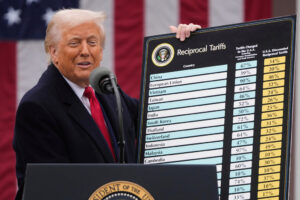Transatlantic Unity in a Changing World
The eminent reminder from historian and political philosopher Hannah Arendt, that “no matter how much we may be capable of learning from the past, it will not enable us to know the future,” serves as a caution against complacency. Indeed, there remains a slim chance that Europeans or Americans could opt to forsake a historically beneficial relationship. Nevertheless, the stage is now set for the transatlantic powers to forge unity in the face of unprecedented challenges. If this relationship successfully weathers these trials, it falls upon American and European leaders to take the necessary steps to ensure that any clash between the two sides of the Atlantic remains nothing more than a concern among the skeptics.

Image Credit: LukeOnTheRoad / Shutterstock.com
For many observers, Trump’s presidency had put the final nail in the transatlantic coffin after more than two decades of strained relationships. However, as Europeans and Americans unite in their hopes for a successive Ukrainian counteroffensive, the transatlantic link is showing signs of unity, strength, and resilience that would suggest its gradual repair. Such a reality stands in stark contrast to the bold prediction made by Charles Kupchan, who asserted that “the next clash of civilizations will be…between the United States and Europe.” But his words, written twenty years ago, did not elicit the shocked gasps that they would today. In fact, his prediction echoed the prevailing sentiment on both sides of the Atlantic at that time.
Why were Kupchan’s words perceived as a fair assessment of the transatlantic link, and how did the U.S. and Europe escape his bleak prediction? To answer this question, we must first take a short walk through the history of the relationship.
It would be misguided to view the construction of the transatlantic link as merely an American “imperialist” project driven solely by self-interest, as some critics like Professor Noam Chomsky suggest. In reality, many Europeans saw the post-World War II reconstruction of Europe as a joint mission with the U.S., and the “extraordinary historical accomplishment” of bringing peace and stability to a continent plagued by a history of war would have been near-impossible without America’s involvement.
Of course, American self-interest was conspicuous in Europe, particularly in balancing against Soviet power in the East. Europe’s own self-interest should not be overlooked either. While the political scientist Robert Kagan goes so far as to suggest that America’s security guarantee allowed Europe to escape the “immortal horrors of the Hobessian world”, at the very least, Western Europe’s ability to delegate matters of “high” politics to the U.S. through NATO was vital for the acquisition of civilian power, which hinged on prioritizing economic matters, diplomatic relations and international institutions. The presence of self-interest on both sides, however, should not overshadow the ideological convergence that existed between the U.S. and Europe. Shared principles of liberal democracy, multilateralism, and diplomacy were defining elements of their relationship, contributing to its strength and endurance.
The end of the Cold War presented a new test to the relationship. With America’s global hegemony expanding through unipolarity, and European nations working to unite their continent, stark differences in their approaches on the global stage became apparent. Europe, under the leadership of the EU, remained committed to employing its civilian power, with an increased emphasis on the process of institutionalization. The U.S., on the other hand, often embarked on a route of “hard” power, which involved “getting below the skin of actors” in order to achieve the desired change. This approach peaked during the onset of the War on Terror when America’s already-weakened commitments to multilateralism and diplomacy were replaced by “coalitions of the willing”.
This posed a dilemma to an expanded EU for two reasons. Firstly, the EU faced an increasing gap between what it was capable of achieving and what was expected of it. This predicament was exacerbated by its apparent inability to effectively wield a “second western voice in international diplomacy,” which could have served as a compelling alternative to the leadership of the U.S. The crisis in Kosovo, marked by America’s imposition of its military dominance in Europe, signified the end to an era characterized by an equal partnership between the EU and the U.S. This was evident as the U.S. circumvented the UN Security Council procedures and ultimately turned “an already bad situation into a humanitarian crisis.”
Secondly, the EU was mindful of the need to avoid engaging in politics that could be perceived as having a “disconnect between narrative and practice.” Such a situation could have undermined the coherence and legitimacy of the EU’s efforts to promote shared practices and values across the continent. The U.S., however, was less cautious of rhetorical contradictions in its realpolitik foreign policy, often combining bilateral relations that served its geopolitical interests with messages of democratization and institutionalization.
This conundrum, compounded by different “social models” and “political cultures,” as Kupchan suggested, inevitably led to a clash between the two sides appearing as a matter of ”when,” rather than “’if.” Initially, there was optimism that a change in American leadership and the withdrawal of Western armed forces from Iraq could pave the way for the revival of the transatlantic link. However, the challenges presented by Obama’s and Trump’s presidency, despite being very different in nature, both undermined such hopes.
During Obama’s time in office, some Atlanticist voices grew disillusioned with American conduct on the global stage. Obama seemed to turn a blind eye to Russia’s annexation of Crimea, which suggested his willingness to allow Putin his own “sphere of influence” in Eastern Europe. Similarly, even though the former president involved U.S. forces in Syria following the Arab Spring rebellions, some assert that he had “no intention to push for a peaceful settlement.” This contributed to the prolonged upheaval in the region, resulting in constant refugee flows to the European continent, which many European leaders proved inapt to handle. The consequences of this, particularly the rise of far-right anti-immigrant sentiments within European politics, are felt to this day.
The turmoil triggered by Trump’s presidency, prompting French President Emmanuel Macron to declare NATO “brain dead,” stemmed from America’s diminished global presence, which raised doubts about its commitment to uphold America’s security guarantee in Europe. This concern was aggravated by Trump’s public accusations of unequal financial contributions to sustain NATO operations. Ironically, in 2018, thirteen NATO members outperformed the U.S. in terms of the percentage of gross national income (GNI) spent on Official Development Assistance (ODA).
Even amidst the turbulence of the Obama and Trump presidencies, both sides of the Atlantic were gradually acknowledging the essence of their predicament. The failures to coordinate a common foreign policy reiterated to European powers the value of military cooperation within NATO. Similarly, the U.S. came to terms with the limitations of its attempts to shape the world solely through “hard power” and instead started to appreciate the role of the EU and its use of civilian power for shared global missions, such as promoting democratic freedom, nuclear disarmament, and the fight against terrorism. In that regard, a fundamental truth remains inescapable: a strong America is indispensable for a strong Europe, and vice versa.
Biden’s arrival heralded a pivotal moment, affirming a deeper appreciation for this truth and igniting a reinvigorated commitment to bridging the Atlantic divide. For example, President Biden was quick to reintegrate the U.S. into global initiatives on crucial issues such as climate change, where the EU has always been a central partner. Meanwhile, the War in Ukraine stands as a poignant reminder of the constraints of civilian power in Europe, compelling a coordinated response from the EU and the U.S. Despite questionable delays and inconsistencies, this joint effort helped stymie Russian aggression.
Undoubtedly, the horizon looms the next substantial test, with three main challenges taking center stage in the current climate. First and foremost, the question of Ukraine’s NATO membership remains a major point of contention among the alliance’s members. The recent NATO summit in Vilnius is widely regarded as a success by bringing Ukraine one step closer to joining the alliance, as well as solidifying significant military aid and ensuring a fast-tracked accession by removing the prerequisite of a membership action plan (MAP). However, the summit failed to offer specific details regarding the timing and external conditions for extending an invitation to Ukraine. This lack of clarity and decisiveness poses a potential risk of fostering internal divisions within the alliance, particularly considering the resolute support for Ukraine’s membership among the majority of NATO members.
Secondly, and crucially related to the previous point, the U.S. and the EU must devise practical measures, whether in the form of a carrot or, more likely, a stick, to rein in the voices within NATO and the EU that have been undermining the cohesiveness of the Western response. This requires not only implementing more rigorous restrictions to prevent Russian companies from evading sanctions but also demonstrating firmness in dealing with Turkey and Hungary, both of whom have hindered the coordination of policy. Encouragingly, progress has been made in overcoming Turkey’s resistance to Sweden’s NATO accession. Nevertheless, Hungarian Prime Minister Victor Orban’s recent comments questioning Ukraine’s sovereignty and whether or not Putin is a war criminal underscore the urgency of addressing this matter.
Lastly, the transatlantic community has to decide its stance on the “Russian question” that is bound to gain prominence toward the end of the war, especially if Ukraine’s victory (i.e. the re-establishment of its 1991 borders) becomes evident. Such an outcome could mark the end of Putin’s regime, setting in motion a plethora of possible scenarios, ranging from the tumultuous breakup of the Russian Federation to a potential wave of democratization. This warrants European and American leaders to start preparing a contingency plan, considering that the situation might rapidly spiral beyond their control.
Of course, there are no guarantees that these obstacles will be easily overcome. Likewise, there is no guarantee that Kupchan’s solemn words do not eventually come to pass. The eminent reminder from historian and political philosopher Hannah Arendt, that “no matter how much we may be capable of learning from the past, it will not enable us to know the future,” serves as a caution against complacency. Indeed, there remains a slim chance that Europeans or Americans could opt to forsake a historically beneficial relationship. Nevertheless, the stage is now set for the transatlantic powers to forge unity in the face of unprecedented challenges. If this relationship successfully weathers these trials, it falls upon American and European leaders to take the necessary steps to ensure that any clash between the two sides of the Atlantic remains nothing more than a concern among the skeptics.




